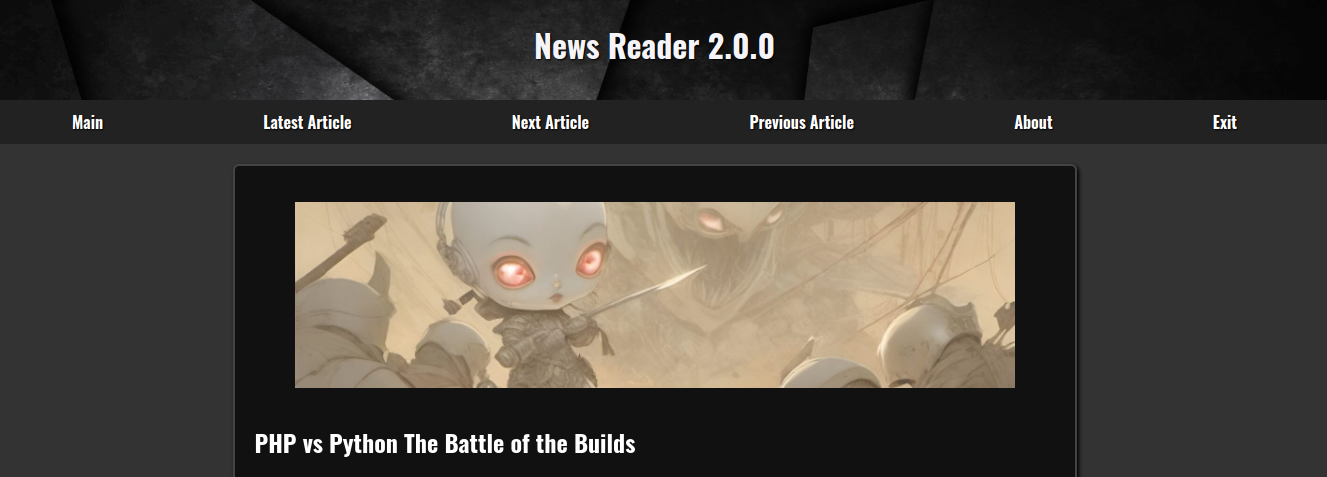News Reader Application 2.0
News Reader Application 2.0
The News Reader Application is a simple, yet powerful tool for browsing articles from a WordPress-based website. Designed with an intuitive user interface, this application fetches and displays articles from a specified WordPress blog, allowing users to navigate between the latest, next, and previous articles seamlessly.
News Reader Application 2.0
Download: reader_2.0.0.zip
Linux/MacOS
(7.81MB)
Key Features:
- Article Navigation:
Effortlessly move between articles with navigation options for “Next” and “Previous” articles. - Latest Article Display:
The app dynamically fetches and presents the latest article from the WordPress feed, ensuring that you are always up to date with fresh content. - Version Management:
Includes built-in version checking (In Version 2.0) to ensure that users are running the latest version of the app, with automatic update alerts. - Responsive Design:
The application uses a clean, responsive design that works well on both desktop and mobile devices. - Customizable Template:
A simple, internal HTML page serves as the main dashboard, which can be easily customized to fit your needs. - Error Handling:
Includes error logging and handling mechanisms to ensure smooth operation, even when things go wrong. - Supported OS: Linux / Mac
Update Notes:
- Improved Performance and Bug Fixes.
- Update Feature Enabled.
- URL Redirect and Script Termination on Exit.
- Default Template Port: 12345
- Updated CSS
The News Reader app is built using Python and Flask, leveraging web scraping techniques with BeautifulSoup to retrieve content from WordPress sites. It integrates smooth navigation features, providing a user-friendly experience for browsing articles with minimal effort.
This app is versatile and can be extended to meet various custom requirements with minor modifications to its functionality and interface.
Custom Use Versions of This Application Include:
- Catalogs:
Display detailed product catalogs with descriptions, images, and pricing. Useful for e-commerce and inventory management. - Documents and Handbooks:
Host and present company policies, user manuals, or training materials in a structured format. - Advertising:
Showcase sales specials, promotions, and dynamic product viewing for marketing campaigns. - Event Schedules:
Publish and navigate through event agendas, schedules, or timetables for conferences or workshops. - Portfolio Displays:
Present creative work like artwork, photography, or projects for freelancers and agencies. - Educational Content:
Deliver lessons, tutorials, or academic resources with easy navigation between chapters or topics. - Recipes:
Build a recipe repository where users can browse, save, and explore culinary ideas. - Tourism Guides:
Provide detailed travel guides, itineraries, and points of interest for tourists. - Project Documentation:
Host technical documentation, changelogs, or development guides for teams and clients. - Customer Testimonials:
Highlight user reviews and success stories to build brand trust. - Newsletters:
Organize and present past newsletters or blog posts for easy access. - Product Comparisons:
Offer interactive product comparison tools for customers to make informed decisions. - Storytelling and E-books:
Present serialized stories, novels, or e-books with seamless navigation between chapters. - FAQs and Knowledge Bases:
Serve as a centralized hub for frequently asked questions or self-help articles. - Case Studies and Reports:
Display analytical content like case studies, white papers, or business reports. - Nonprofit Updates:
Share updates, success stories, and upcoming campaigns for charities and nonprofits. - Community Boards:
Enable users to post and view announcements, classifieds, or bulletins. - Company Newsfeeds:
Present organizational updates, press releases, or employee spotlights. - Photo Galleries:
Showcase collections of images or themed galleries with descriptions. - Video Libraries:
Offer access to a library of video tutorials, demos, or vlogs.









